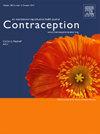美国变性男性和不同性别者使用避孕药具的情况:使用、不使用的原因以及用于避孕的方法。
IF 2.3
2区 医学
Q1 OBSTETRICS & GYNECOLOGY
引用次数: 0
摘要
目的:描述变性男性和出生时被分配为女性或双性人(AFIAB)的变性人为避孕而使用避孕药具的情况,并探讨使用睾酮是否会导致避孕药具使用情况的不同:描述变性男性和性别多元化(TGD)个体(AFIAB)为避孕而使用避孕药具的情况,并探讨避孕药具的使用是否因睾酮的使用而有所不同:我们分析了一项横断面在线调查的数据,调查对象为 2019 年通过面向社区的网站招募的 N=1,694 名 AFIAB TGD 个人,以及一项针对美国性少数群体和/或性别少数群体 (SGM) 成年人的全国性社区参与队列研究。描述性分析和回归分析描述了目前和曾经使用避孕方法避孕的情况,按睾酮使用情况进行了分层,并描述了使用/不使用避孕方法的原因:大多数受访者(71.0%)以前使用过避孕药具,其中 49.4% 用于避孕。最常用的避孕方法包括:外用避孕套(91.8%)、复合激素避孕药(63.0%)和体外射精(45.9%)。目前最常用的避孕方法包括:外用避孕套(35.4%)、荷尔蒙宫内节育器(24.8%)和禁欲(19.2%)。有些人表示以前(55 人,6.6%)或现在(30 人,3.6%)依靠睾酮避孕。在 33 个使用和不使用避孕药具的原因中,只有 4 个原因因使用睾酮组别而异。报告最多的从未使用避孕药具的原因是不进行阴茎插入阴道的性行为(5.7%)或不与产生精子的个体发生性行为(4.8%):结论:大多数 AFIAB 同性恋者都采取过避孕措施,其中近一半是为了避孕。最常用的方法只需与医疗保健系统进行最少和/或非侵入性的互动。一些受访者依靠睾酮避孕,尽管缺乏有效性证据。本文章由计算机程序翻译,如有差异,请以英文原文为准。
Contraceptive use among transgender men and gender diverse individuals in the United States: Reasons for use, non-use, and methods used for pregnancy prevention
Objectives
To describe contraceptive use for pregnancy prevention among transgender men and gender diverse (TGD) individuals assigned female or intersex at birth (AFIAB) and explore whether contraceptive use differs by testosterone use.
Study design
We analyzed data from a cross-sectional, online survey of N = 1694 TGD individuals AFIAB recruited in 2019 through a community-facing website and a national community-engaged cohort study of sexual and/or gender minority (SGM) adults in the US. Descriptive and regression analyses characterized the current and ever use of contraceptive methods for pregnancy prevention, stratified by testosterone use, and described reasons for contraceptive use/non-use.
Results
Most respondents (71.0%) had used contraception before with 49.4% using it for pregnancy prevention. The methods that were most frequently ever used for pregnancy prevention included: external condoms (91.8%), combined hormonal contraceptive pills (63.0%), and withdrawal (45.9%). The methods most frequently currently used for pregnancy prevention included: external condoms (35.4%), hormonal intrauterine device (IUD) (24.8%), and abstinence (19.2%). Some reported formerly (n = 55, 6.6%) or currently (n = 30, 3.6%) relying on testosterone for pregnancy prevention. Only four of the 33 reasons for contraceptive use and non-use differed by testosterone use group. The most reported reasons for never using contraception were not engaging in penis-in-vagina sex (5.7%) or no sex with individuals who produce sperm (4.8%).
Conclusions
Most TGD individuals AFIAB have used contraception, and almost half for pregnancy prevention. The most used methods require minimal and/or non-invasive healthcare system interaction. Some respondents relied on testosterone as birth control, despite a lack of efficacy evidence.
Implications
TGD individuals use a range of birth control methods for pregnancy prevention and clinicians should not assume preferences for certain forms of contraception based on gender identity (e.g., estrogen avoidance). Clinicians should engage in patient-centered counseling and shared decision-making to provide high-quality contraceptive care to patients of all genders.
求助全文
通过发布文献求助,成功后即可免费获取论文全文。
去求助
来源期刊

Contraception
医学-妇产科学
CiteScore
4.70
自引率
17.20%
发文量
211
审稿时长
69 days
期刊介绍:
Contraception has an open access mirror journal Contraception: X, sharing the same aims and scope, editorial team, submission system and rigorous peer review.
The journal Contraception wishes to advance reproductive health through the rapid publication of the best and most interesting new scholarship regarding contraception and related fields such as abortion. The journal welcomes manuscripts from investigators working in the laboratory, clinical and social sciences, as well as public health and health professions education.
 求助内容:
求助内容: 应助结果提醒方式:
应助结果提醒方式:


